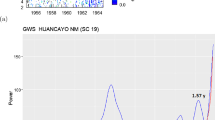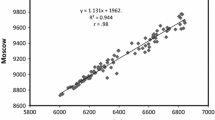Abstract
Several studies show that temporal variations in the Galactic cosmic ray (GCR) intensity display a distinct 11-year periodicity due to solar modulation of the galactic cosmic rays in the heliosphere. The 11-year periodicity of GCRs is inversely proportional to, but out of phase with, the 11-year solar cycle, implying that there is a time lag between actual solar cycle and the GCR intensity, which is known as the hysteresis effect. In this study, we use the hysteresis effect to model the relationship between neutron counting rates (NCRs), an indicator of the GCR intensity, and sunspot numbers (SSNs) over the period that covers the last four solar cycles (20, 21, 22, and 23). Both linear and ellipse models were applied to SSNs during odd and even cycles in order to calculate temporal variations of NCRs. We find that ellipse modeling provides higher correlation coefficients for odd cycles compared to linear models, e.g. 0.97, 0.97, 0.92, and 0.97 compared to 0.69, 0.72, 0.53, and 0.68 for data from McMurdo, Swarthmore, South Pole, and Thule neutron monitors, respectively, during solar cycle 21 with overall improvement of 31 % for odd cycles. When combined to a continuous model, the better correlation observed for the odd cycles increases the overall correlation between observed and modeled NCRs. The new empirical model therefore provides a better representation of the relationship between NCRs and SSNs. A major goal of the ongoing research is to use the new non-linear empirical model to reconstruct SSNs on annual time scales prior to 1610, where we do not have observational records of SSNs, based on changes in NCRs reconstructed from 10Be in ice cores.










Similar content being viewed by others
Notes
References
Ahluwalia, H.S., Ygbuhay, R.C.: 2012, Adv. Space Res. 49, 493.
Alanko-Huotari, K., Usoskin, I.G., Mursula, K., Kovaltsov, G.A.: 2007, J. Geophys. Res. 112, 8101.
Bard, E., Frank, M.: 2006, Earth Planet. Sci. Lett. 248, 1.
Baroni, M., Bard, E., Petit, J.-R., Magand, O., Bourlès, D.: 2011, Geochim. Cosmochim. Acta 75, 7132.
Belov, A.: 2000, Space Sci. Rev. 93, 79.
Chowdhury, P., Kudela, K., Dwivedi, B.N.: 2013, Solar Phys. 286, 577.
Dunai, T.J.: 2010, Cosmogenic Nuclides: Principles, Concepts and Applications in the Earth Surface Sciences, Cambridge University Press, Cambridge, 2.
Gupta, M., Mishra, V.K., Mishra, A.P.: 2006, J. Astrophys. Astron. 27, 455.
Hale, G.E., Ellerman, F., Nicholson, S.B., Joy, A.H.: 1919, Astrophys. J. 49, 153.
Hathaway, D.H.: 2010, Living Rev. Solar Phys. 7(1). http://solarphysics.livingreviews.org/Articles/lrsp-2010-1/ .
Heikkilä, U., Beer, J., Jouzel, J., Feichter, J., Kubik, P.: 2008, Geophys. Res. Lett. 35, 5817.
Hoyt, D.V., Schatten, K.H.: 1993, J. Geophys. Res. 98, 18895.
Jokipii, J.R.: 2011, In: The 2011 Heliophysics Summer School, Boulder. http://www.vsp.ucar.edu/Heliophysics/pdf/2011_Jokipii_Cosmic-Rays-Lecture.pdf .
Jokipii, J.R., Levy, E.H., Hubbard, W.B.: 1977, Astrophys. J. 213, 861.
Lean, J.: 2000, Geophys. Res. Lett. 27, 2425.
Mavromichalaki, H., Petropoulos, B.: 1984, Astrophys. Space Sci. 106, 61.
Mavromichalaki, H., Petropoulos, B.: 1987, Earth Moon Planets 37, 79.
Mavromichalaki, H., Belehaki, A., Rafios, X., Tsagouri, I.: 1996, Astrophys. Space Sci. 246, 7.
Mavromichalaki, H., Marmatsouri, E., Vassilaki, A.: 1990, Solar Phys. 125, 409.
Mavromichalaki, H., Paouris, E., Karalidi, T.: 2007, Solar Phys. 245, 369.
Marmatsouri, L., Vassilaki, A., Mavromichalaki, H., Petropoulos, B.: 1995, Adv. Space Res. 16, 245.
Mavromichalaki, H., Belehaki, A., Rafios, X.: 1998, Astron. Astrophys. 330, 764.
Nagashima, K., Morishita, I.: 1980, Planet. Space Sci. 28, 195.
Otaola, J.A., Perez-Enriquez, R., Valdes-Galicia, J.F.: 1985, 19th Int. Cosmic Ray Conf. 4, 493.
Owens, M.J., Usoskin, I., Lockwood, M.: 2012, Geophys. Res. Lett. 39, 19102.
Paouris, E., Mavromichalaki, H., Belov, A., Gushchina, R., Yanke, V.: 2012, Solar Phys. 280, 255.
Parker, E.N.: 1965, Planet. Space Sci. 13, 9.
Potgieter, M.S., Burger, R.A., Ferreira, S.E.S.: 2001, Space Sci. Rev. 97, 295.
Singh, M., Singh, Y.P., Badruddin: 2008, J. Atmos. Solar-Terr. Phys. 70, 169.
Solanki, S.K., Usoskin, I.G., Kromer, B., Schüssler, M., Beer, J.: 2004, Nature 431, 1084.
Usoskin, I.G., Kananen, H., Mursula, K., Tanskanen, P., Kovaltsov, G.A.: 1998, J. Geophys. Res. 103, 9567.
Usoskin, I.G., Gladysheva, O.G., Bobik, P., Kudela, K., Kananen, H.: 1999, Czechoslov. J. Phys. 12, 49.
Usoskin, I.G., Bobik, P., Gladysheva, O.G., Kananen, H., Kovaltsov, G.A., Kudela, K.: 2001, Adv. Space Res. 27, 565.
Van Allen, J.A.: 2000, Geophys. Res. Lett. 27, 2453.
Webber, W.R., Lockwood, J.A.: 1988, Geophys. Res. Lett. 93, 8735.
Acknowledgements
Funding for the Stellar Astrophysics Centre is provided by the Danish National Research Foundation (Grant agreement no.: DNRF106). MFK, CK and JO acknowledged support from the Carlsberg Foundation. Neutron monitors of the Bartol Research Institute are supported by the United States National Science Foundation (Grant agreement numbers: ANT-0739620 and ANT-0838839), and by the University of Delaware Department of Physics and Astronomy and Bartol Research Institute.
Author information
Authors and Affiliations
Corresponding author
Rights and permissions
About this article
Cite this article
Inceoglu, F., Knudsen, M.F., Karoff, C. et al. Modeling the Relationship Between Neutron Counting Rates and Sunspot Numbers Using the Hysteresis Effect. Sol Phys 289, 1387–1402 (2014). https://doi.org/10.1007/s11207-013-0391-8
Received:
Accepted:
Published:
Issue Date:
DOI: https://doi.org/10.1007/s11207-013-0391-8




